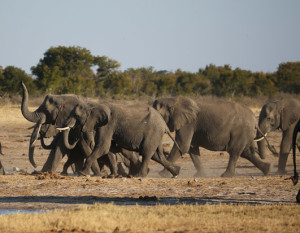 Cyanide is a rapidly acting, potentially deadly chemical. It exists in various forms such as hydrogen cyanide (HCN) which is a colourless gas, or as crystals such as sodium cyanide (NaCN) or potassium cyanide (KCN). Cyanide is sometimes described as having a “bitter almond” smell when mixed with liquid, although not everyone can detect this odour.
Cyanide is a rapidly acting, potentially deadly chemical. It exists in various forms such as hydrogen cyanide (HCN) which is a colourless gas, or as crystals such as sodium cyanide (NaCN) or potassium cyanide (KCN). Cyanide is sometimes described as having a “bitter almond” smell when mixed with liquid, although not everyone can detect this odour.
Cyanide is readily absorbed by inhalation, ingestion or skin contact. The cyanide compound used to poison elephants is sodium cyanide, a powder that is relatively easy to obtain as it is used extensively in the mining industry. It is transported as dry pellets.
In the poisoning of elephants sodium cyanide is typically mixed with salt and placed in different areas near a waterhole or salt lick so as to affect a number of animals at the same time. Elephants crave salt for its mineral content in their diet, so they consume the contaminated salt mixture. A dose of 100 – 200 grams of sodium cyanide is enough to kill a large bull elephant, less for females and youngsters.
Ingested sodium cyanide readily dissolves in the liquids in the stomach and quickly enters the bloodstream to be distributed throughout the body. It is a rapidly acting, potent asphyxiant as it acts at cellular level to inhibit the enzyme that enables cells to use oxygen. The oxygen-starved cells are unable to produce energy from glucose. The vital organs that most need energy, namely the brain, heart, and lungs are most affected. Fatigue, weakness and collapse are followed by convulsions, inability to breathe, coma, cardiac arrest and death. A lethal dose of cyanide acts within hours, and poisoned animals rarely move far from the place of poisoning before death occurs.
It is a common misconception that sodium cyanide is used to contaminate the water at a water hole. This is unlikely, as the cyanide would be too diluted to deliver a lethal dose. Sodium cyanide readily reacts with water at a normal pH of about 7 to produce hydrogen cyanide gas, and although highly toxic, this gas is very volatile, so it evaporates and disperses into the air in a process that naturally detoxifies the water. In addition, cyanide binds with other compounds in water and settles out as sediment. Various microbes present in the water also help to break it down.
Contrary to what has been publicized the knock on effect of cyanide poisoning is surprisingly minimal. It is not biomagnified in food chains, nor does it cycle extensively in ecosystems largely because it is broken down so fast. Animals that ingest sub lethal doses of cyanide are able to metabolize and excrete it in the urine with relative ease. This rapid detoxification enables predators to ingest high sub lethal doses of cyanide over extended periods without harm. Vultures seem to be the most affected probably because they eat the stomach contents of poisoned animals where the concentration of cyanide is likely to be high enough to deliver a lethal dose.
The poaching of our elephants is an abomination and we need solutions to combat it urgently. Much more needs to be done both within Zimbabwe and internationally to safeguard and protect these magnificent, grey giants of the wilderness.